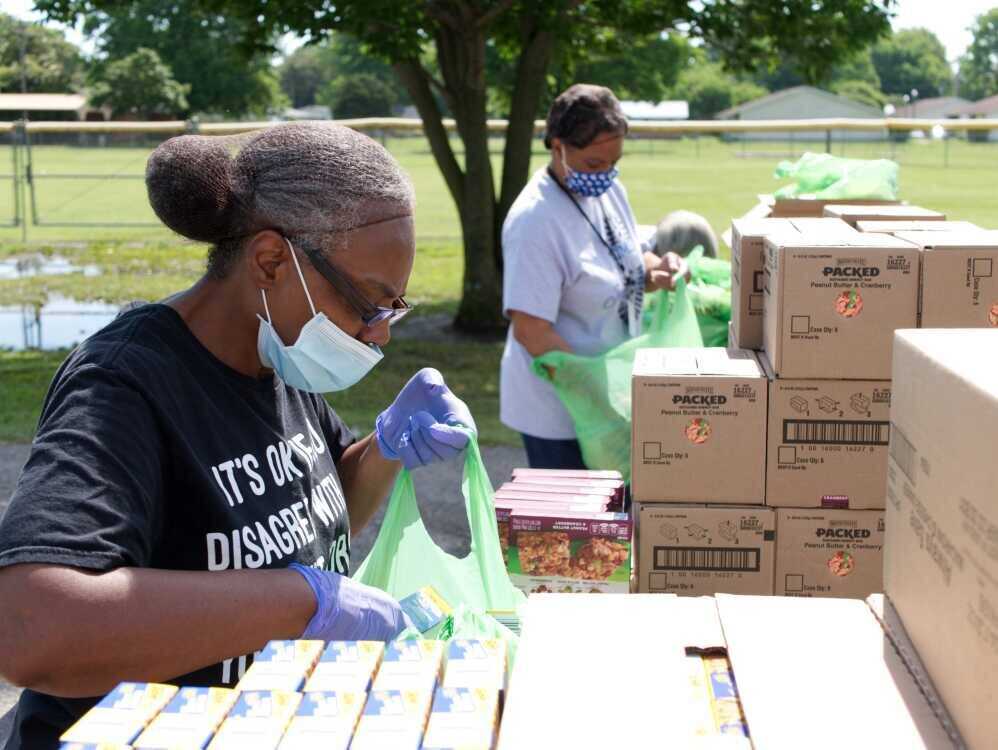Businesses, organizations tackle food insecurity in the ‘land of plenty’

Food insecurity continues to be an issue in the United States, including in agriculturally-rich Southeast Missouri. Some of the area’s most rural communities continue to be the hardest hit, with the COVID-19 pandemic also contributing to the challenges.
However, thanks to organizations such as the SEMO Food Bank, schools, churches and local businesses, efforts are being made to tackle the challenge and minimize its effects in Southeast Missouri.
A working definition
Not-for-profit Feeding America, whose data Southeast Missouri Food Bank officials often quote, defines food insecurity as “a lack of consistent access to enough food for every person in a household to live an active, healthy life.”
Pandemic impact
Feeding America, drawing on United States Department of Agriculture (USDA) statistics, estimated 42 million people, one in eight Americans, experienced some kind of food insecurity last year — driven in part by COVID-19, “which put further strain on households already experiencing food hardship,” said USDA.
Regional statistics
Stacker.com, a five-year old newswire and media company, compiled a list of counties in Missouri with the highest rate of food insecurity using Feeding America research statistics.
The state’s 114 counties were ranked by highest percent of population with food insecurity as of 2019 — the latest figures available.
Southeast Missouri, home to one of America’s richest agricultural regions, had a number of counties on the insecure list.
The bootheel’s Pemiscot County, home to Hayti and Caruthersville, was ranked no. 1, out of 114 counties, for food insecurity in the state on a percentage of population basis.
Others:
No. 6: Dunklin County (Kennett)
No. 7: Butler County (Poplar Bluff)
No. 9: New Madrid County
No. 10: Mississippi County (Charleston)
No. 11: Wayne County (Piedmont; Greenville)
No. 22: Scott County (Scott City, Sikeston, Chaffee)
No. 25: Stoddard County (Dexter, Bloomfield, Advance)
No. 47: Bollinger County (Marble Hill)
Former U.S. Secretary of State Henry Kissinger predicted at 1974’s World Food Conference “within a decade, no child should go to bed hungry.”
More than three decades later, author Mark Winne laid out what he saw as an expanding problem in America: not merely hunger but the easy availability of non-nutritious food.
In his 2008 book, “Closing the Food Gap: Resetting the Table in the Land of Plenty,” Winne explained his premise.
“Almost everybody who grew up in the 1950s and 1960s has a story to tell about bad food. The children of that era are uncompensated victims of the Good Housekeeping promise that canned, frozen and prepackaged food would free humanity. If there is a generation in history entitled to bring a class-action lawsuit against the food industry that first invented this food and then manipulated our mothers into serving it, it is ours. At the trial, such items such as canned peas and soup, Pop-Tarts, instant mashed potatoes, certain cereals, TV dinners and Kool-Aid would all be entered into evidence. A jury of our peers would certainly find the defendants guilty after only 10 minutes of deliberation — and a judge would pronounce the maximum sentence possible: the executives of those corporations would have to eat nothing but their own food for 25 years-to-life. And may God have mercy on their souls.”
In 1990, President George H.W. Bush launched a 10-year initiative to assess the “dietary and nutritional status” of Americans via the Nutrition Monitoring and Related Research Act. In that same year, the U.S. Department of Agriculture began using language explaining food insecurity.
Hard choices
In a June 1 news release, Southeast Missouri Food Bank said fully one-third of food insecure households it serves reported having to choose between paying for food and paying for utilities last year.
Additionally, SEMO Food Bank reported 28% were forced to choose between food and medicine/medical care.
The data was compiled from research conducted by University of Missouri social scientists.
“The data from this study, conducted a year ago, reflects what many of our neighbors experience every day,” said Joey Keys, CEO of SEMO Food Bank.
“Inflation, food shortages and rising costs of food and transportation costs {in 2022) have made those challenges even more difficult for families and individuals facing hunger.”
The food bank, headquartered in Sikeston and with plans to open a satellite warehouse this summer in Jackson, said it is spending three times more on food acquisition and distribution compared to prior to the pandemic’s start in March 2010.
More data points
The University of Missouri report also cited the vital connection between food and health by studying information gleaned from individual households.
64% reported purchasing the least expensive food, even if not the healthiest option.
72% of SEMO Food Bank households have a family member with high blood pressure; 59% have a high cholesterol; 50% have either diabetes or pre-diabetes.
“We know access to healthy food is important to overall health and this report underlies that,” Keys said.
“We also know healthier foods like fresh produce and protein often cost the most. (SEMO) Food Bank strives to make healthier foods more accessible to the people we serve.”
Business response
Keys said SEMO Food Bank is indebted to companies who recognize the problem — with special gratitude to Drury Southwest, Midwest Sterilization, Greenway Equipment and Buzzi Unicem.
Craig Conklin, plant manager of Buzzi Unicem at 2524 S. Sprigg St. in Cape Girardeau, reports the cement maker recently has given large donations to the food bank: $50,000, at the end of 2020; and $25,000 at the end of 2021 — aimed at combating food insecurity.
“At each of our (Buzzi) facilities in the U.S., we have a certain number of dollars we’re allowed to donate each year and we know our ownership is big on environmental sustainability, education and community involvement,” said Conklin, who came to the Cape plant four years ago.
“Our plant was down for awhile due to flooding on the Mississippi River. After I caught up with all my paperwork and with little else to do for a period of time, I started to look at local food banks.”
Conklin said he has vivid memories of his mother taking the family to food banks and soup kitchens on Thanksgiving and on Christmas morning to help distribute food while growing up in Traverse City, Michigan.
“In June of 2019, I drove to the Sikeston food bank location and struck up a conversation with one of the employees there. It wasn’t long after that a dozen Buzzi employees were volunteering (at SEMO Food Bank) on a quarterly basis. Later, at a Cape Chamber event, I was asked if the company would do a match on Giving Tuesdays — and we’ve been doing this, too, every year.”
Conklin recalls a particular conversation with Keys and a now-former food bank employee, Lisa Church, about the impact of inflation.
“I remember them telling me about a truckload of peanut butter the food bank had ordered and the cost they said went up somewhere between 30% to 50%, a staggering increase they couldn’t overcome. That’s where Buzzi was trying to help with its dollars,” he said.
School response
Jessica Maxwell is associate superintendent for elementary and student services for Jackson R-2 Schools, a district with 5,600 students from pre-kindergarten through grade 12.
Maxwell, a Jackson graduate, has been on staff at her alma mater for 16 years and is the district’s point person on food insecurity questions.
“We know if kids are hungry, they’re not going to be in a place where they learn well and as a district, it’s a priority that kids are fed. Breakfast and lunch served on our campus are good healthy meals. Because of the federal waiver, as was the case for many school districts, we were able to offer free meals on campus for all of 2021-2022. The numbers of kiddos participating in the program have drastically increased,” she said.
The waiver, to which Maxwell referred, is called Nationwide Waiver to Allow the Seamless Summer Option, which she said began for Jackson at the start of the COVID pandemic in March 2020 and was extended twice, most recently for the just completed academic year.
“During 2021-22, we served 944,000 meals (on-campus). The waiver has ended for us. We’ll be going back to the free and reduced meal option starting with summer school,” Maxwell said.
Another Jackson R-2 food program is called Power Packs, where volunteers pack food bags that are sent home for student use on the weekend.
“We know we have kiddos who struggle with meals outside of the school day, so we’ve made that a priority to provide supplemental food for weekends. We served 326 students with Power Packs this past academic year,” Maxwell said.
“We have folks from the business community come in on Thursdays to pack the bags at our support services building. Once the bags are prepared, they help distribute them to our individual buildings. The district doesn’t pay anything for Power Packs. We raise funds outside of school from businesses and individuals plus a lot of our district employees contribute from their own paychecks.”
Nutrition
“We have tweaked the food we send home because some of what we were sending home were cans that kids couldn’t open with can openers or it was food that had to be put on a stovetop, which is difficult for children to do independently. As a result, it wasn’t getting eaten. We shifted our selections to things such as Ramen noodles, which can be heated up in the microwave, plus tins of macaroni and cheese, granola bars and microwavable soup, too,” Maxwell said.”
Oversight
“The district has five social workers and they play a large role in the organization and facilitation of Power Packs. They meet the volunteers each week and work with them,” Maxwell said.
Another food option Jackson R-2 offers is a mobile food pantry for families on Saturday mornings five times a year at Jackson Middle School.
“The priority is for those families enrolled in Power Packs, but the pantry is open to any of our Jackson families who need it,” Maxwell noted.
“(Families) get around 30 pounds of food to take home, which we get from the food bank — thanks to donations from gracious businesses and churches to supplement the need.”
Postscript
Buzzi Unicem’s Conklin said he is grateful his company is able to help.
“I have two young kids. I can’t imagine if they were in school and had to think a lot about having enough to eat rather than focusing on what they’re learning that day,” he said.
“I think a lot of us are so blessed and sometimes we don’t understand (the problem) until we have the opportunity to help others,” he added.
The complete report for Southeast Missouri Food Bank may be viewed at semofoodbank.org/news-publications/.
The statewide report, “Food Assistance and Hunger in the Heartland 2021,” the first time all six regional food banks partnered to gather qualitative date about hunger, may be seen at foodsecurity.missouri.edu.
































